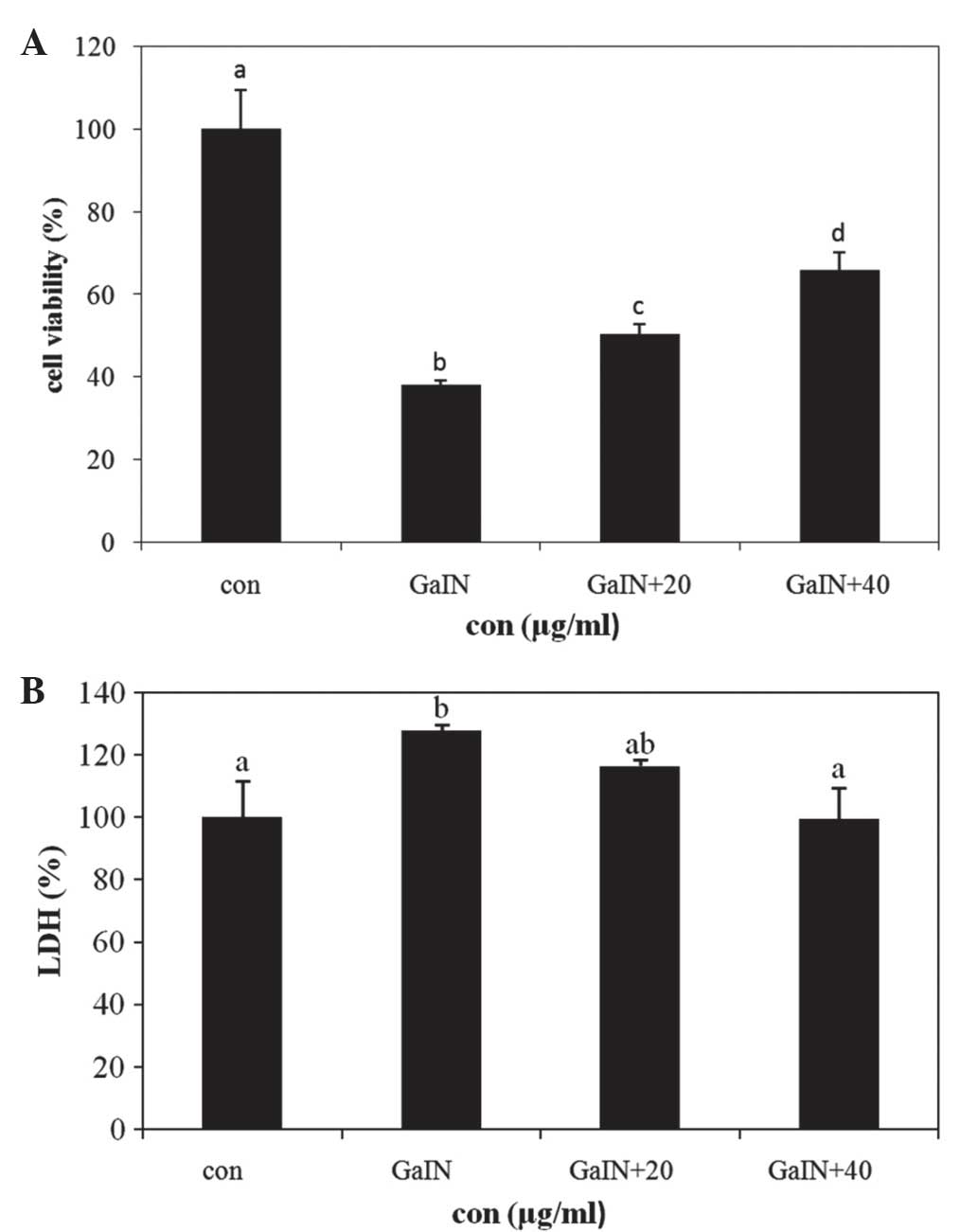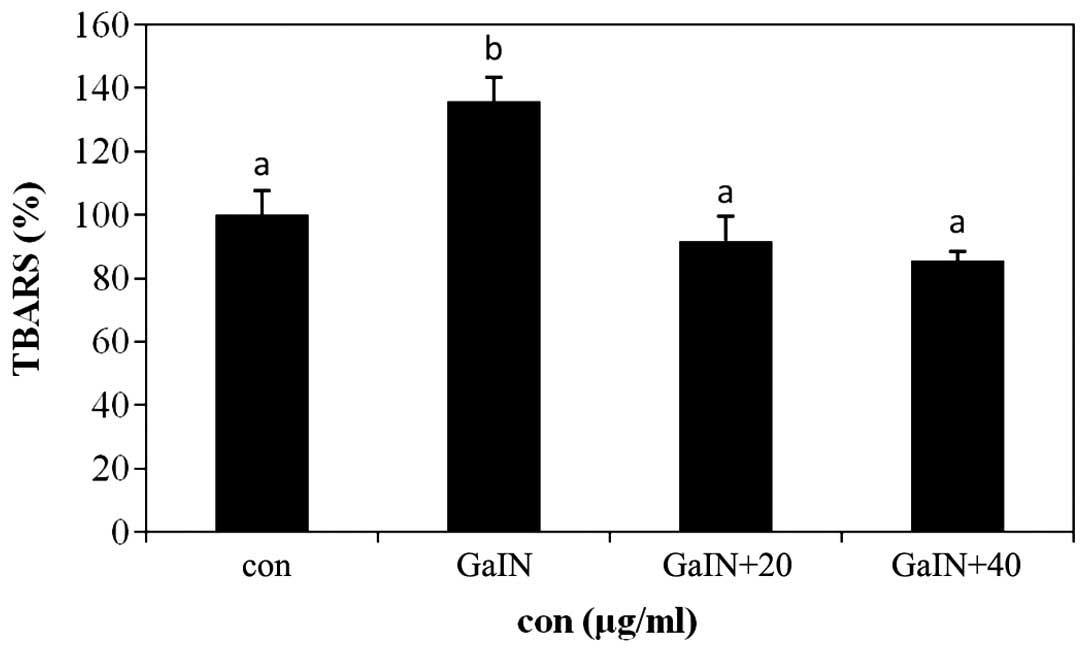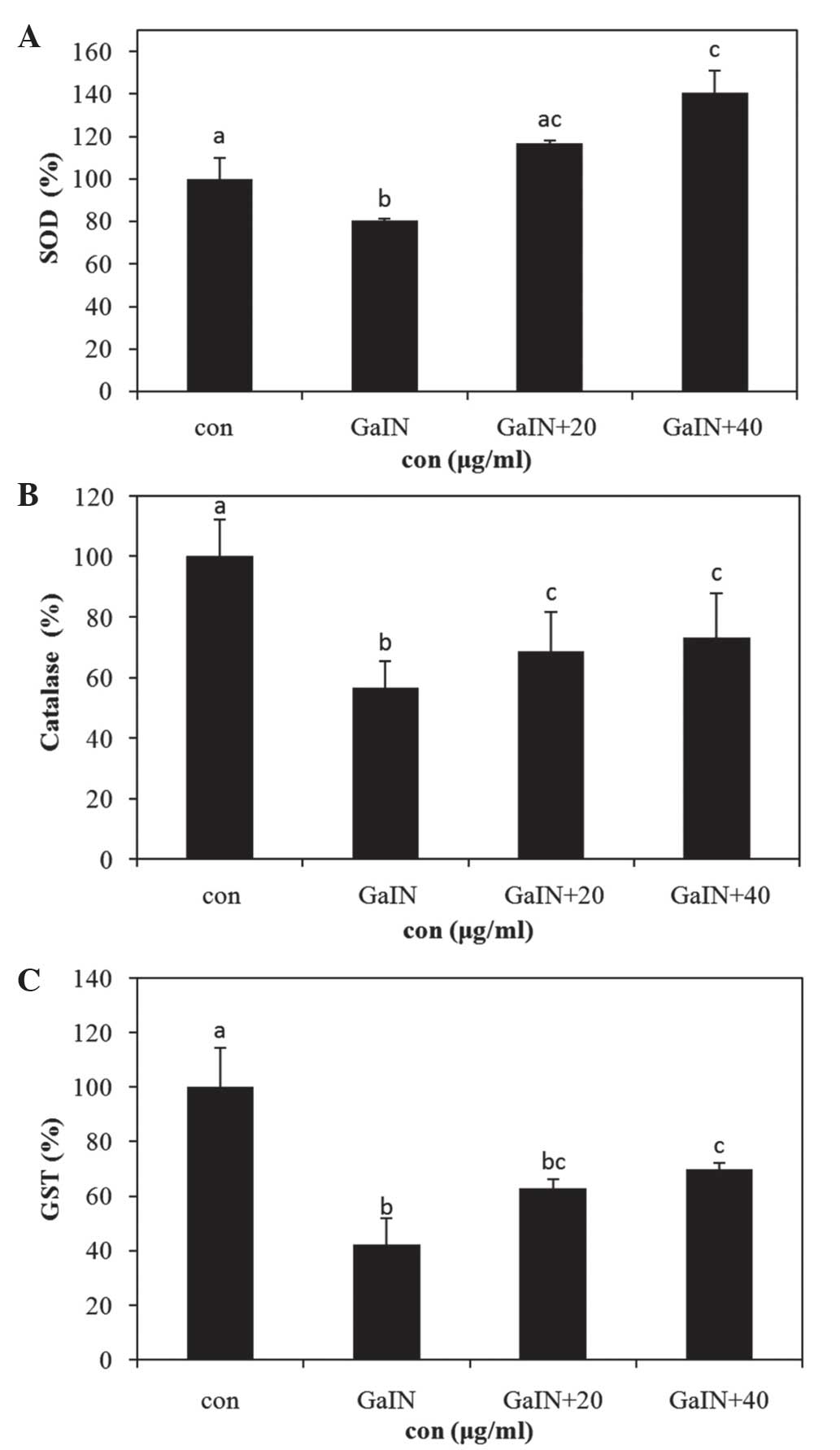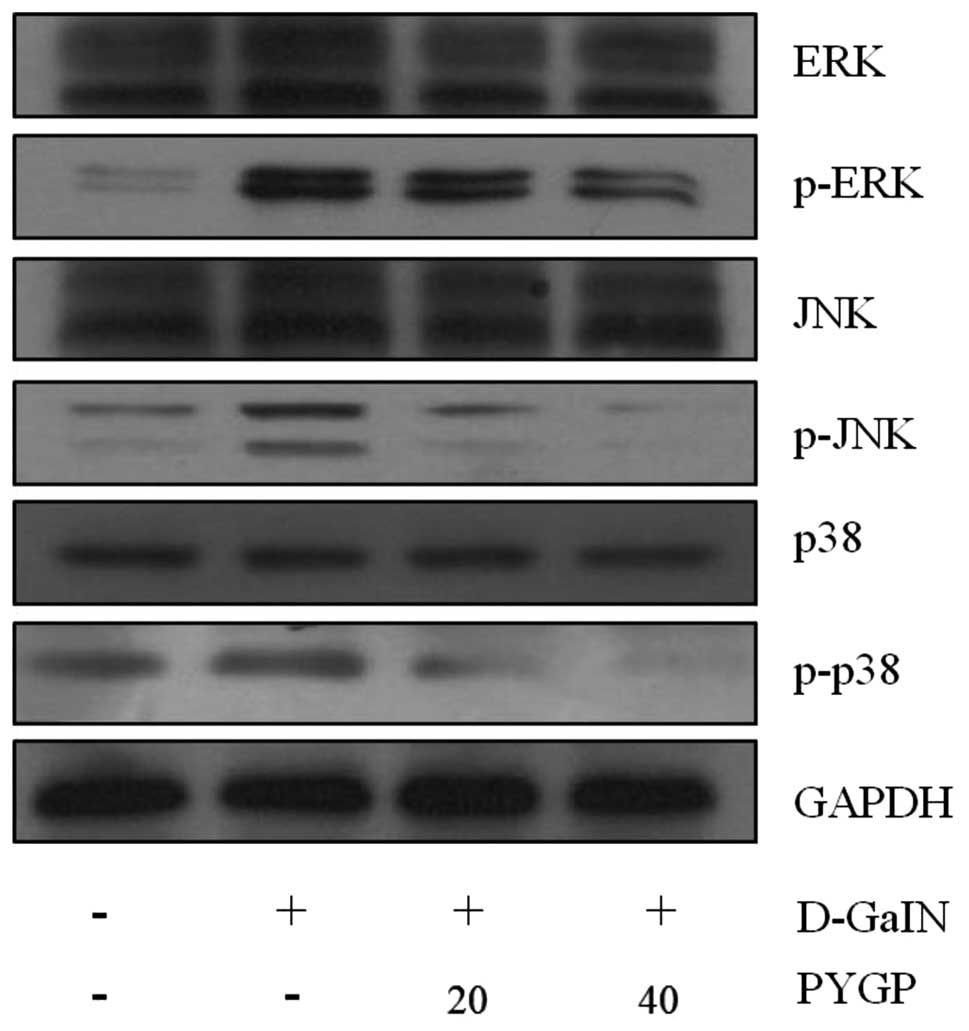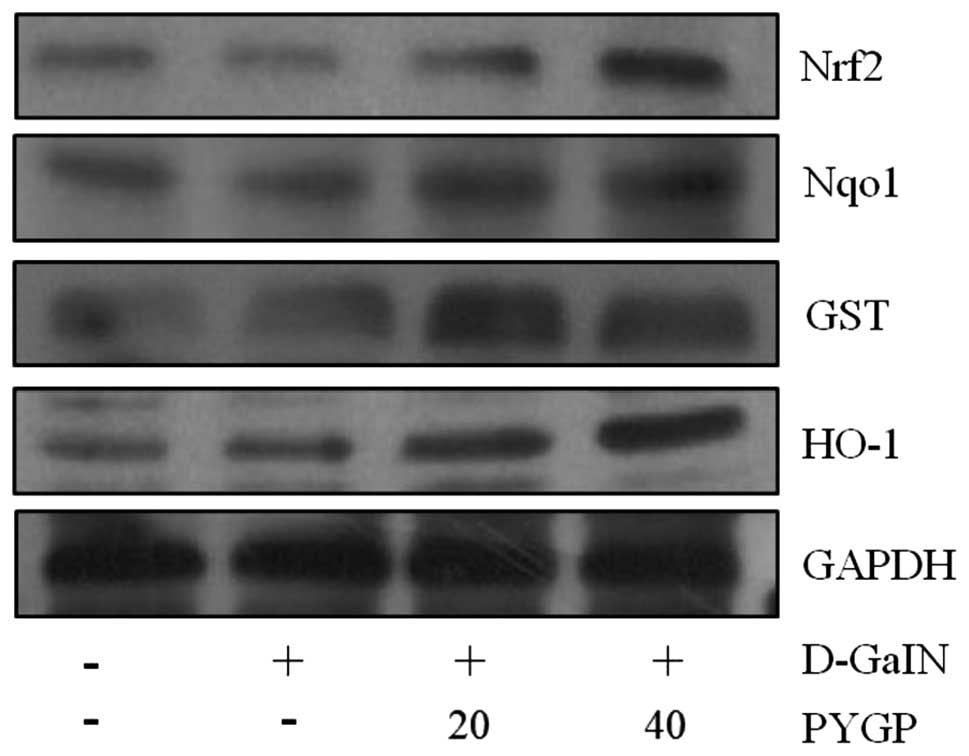|
1
|
Hwang JM, Tseng TH, Tsai YY, Lee HJ, Chou
FP, Wang CJ and Chu CY: Protective effects of baicalein on
tert-butyl hydroperoxide-induced hepatic toxicity in rat
hepatocytes. J Biomed Sci. 12:389–397. 2005. View Article : Google Scholar : PubMed/NCBI
|
|
2
|
Jose M, Javier C, Javier FP, et al:
S-Adenosylmethionine in alcoholic liver cirrhosis: a randomized,
placebo-controlled, double-blind, multicenter clinical trial. J
Hepatol. 30:1081–1089. 1999. View Article : Google Scholar
|
|
3
|
MacDonald JR, Thayer KJ and White C:
Inhibition of galactosamine cytotoxicity in an in vivo/in vitro
hepatocellular toxicity model. Toxicol Appl Pharmacol. 89:269–277.
1987. View Article : Google Scholar : PubMed/NCBI
|
|
4
|
Sakaguchi S and Yokota K: Role of
Ca2+ on endotoxin-sensitivity by galactosamine
challenge: lipid peroxide formation and hepatotoxicity in zymosan
primed mice. Pharmacol Toxicol. 77:81–86. 1995. View Article : Google Scholar : PubMed/NCBI
|
|
5
|
Hou CC, Huang CC and Shyur LF: Echinacea
alkamides prevent lipopolysaccharide/D-galactosamine-induced acute
hepatic injury through JNK pathway-mediated HO-1 expression. J
Agric Food Chem. 59:11966–11974. 2011. View Article : Google Scholar : PubMed/NCBI
|
|
6
|
Cho HI, Park JH, Choi HS, Kwak JH, Lee DU,
Lee SK and Lee SM: Protective mechanisms of acacetin against
D-galactosamine and lipopolysaccharide-induced fulminant hepatic
failure in mice. J Nat Prod. 77:2497–2503. 2014. View Article : Google Scholar : PubMed/NCBI
|
|
7
|
Das J, Ghosh J, Roy A and Sil PC:
Mangiferin exerts hepatoprotective activity against D-galactosamine
induced acute toxicity and oxidative/nitrosative stress via
Nrf2-NFκB pathways. Toxicol Appl Pharmacol. 260:35–47. 2012.
View Article : Google Scholar : PubMed/NCBI
|
|
8
|
Rajesh KT, Kim HM, Sorachai S, Thomas WK,
Masayuki Y and Shyam B: Identification of Nrf2-regulated genes
induced by the chemopreventive agent sulforaphane by
oligonucleotide microarray. Cancer Res. 62:5196–5203. 2002.
|
|
9
|
Martin E, Victoria B, Walter M, Andrea GL
and Patricia GV: The Nrf2-Keap1 cellular defense pathway and heat
shock protein 70 (Hsp70) response. Role in protection against
oxidative stress in early neonatal unilateral ureteral obstruction
(UUO). Cell Stress Chaperones. 16:57–68. 2011. View Article : Google Scholar
|
|
10
|
Dhakshinamoorthy S and Jaiswal AK:
Functional characterization and role of INrf2 in antioxidant
response element-mediated expression and antioxidant induction of
NAD (P) H:quinine oxidoreductase 1 gene. Oncogene. 20:3906–3917.
2001. View Article : Google Scholar : PubMed/NCBI
|
|
11
|
Nishioka H, Kishioka T, Iida C, Fujii K,
Ichi I and Kojo S: Activation of mitogen activated protein kinase
(MAPK) during D-galactosamine intoxication in the rat liver. Bioorg
Med Chem Lett. 16:3019–3022. 2006. View Article : Google Scholar : PubMed/NCBI
|
|
12
|
Sally KN, Swapan KB, Gary KG, Paul M and
Joe MM: The induction of human superoxide dismutase and catalase in
vivo: A fundamentally new approach to antioxidant therapy. Free
Radic Biol Med. 40:341–347. 2006. View Article : Google Scholar
|
|
13
|
Nirupama M and Friedrich HM: reactive
oxygen species: response of algal cells. J Plant Physiol.
157:183–193. 2000. View Article : Google Scholar
|
|
14
|
Chao ES, Dunbar D and Kaminsky LS:
Intracellular lactate dehydrogenase concentration as an index of
cytotoxicity in rat hepatocyte pri mary culture. Cell Biol Toxicol.
4:1–11. 1988. View Article : Google Scholar : PubMed/NCBI
|
|
15
|
Jauregui HO, Hayner NT, Driscoll JL,
Williams-Holland R, Lipsky MH and Galletti PM: Trypan blue dye
uptake and lactate dehydrogenase in adult rat hepatocytes-freshly
isolated cells, cell suspension and primary mono layer cultures. In
Vitro. 17:1100–1110. 1981. View Article : Google Scholar : PubMed/NCBI
|
|
16
|
Allocati N, Federici L, Masulli M and Di
Ilio C: Glutathione transferases in bacteria. Febs J. 276:L58–L75.
2009. View Article : Google Scholar
|
|
17
|
Pushpavalli G, Kalaiarasi P, Veeramani C
and Pugalendi KV: Effect of chrysin on hepatoprotective and
antioxidant status in D-galactosamine-induced hepatitis in rat. Eur
J Pharmacol. 631:36–41. 2010. View Article : Google Scholar : PubMed/NCBI
|
|
18
|
Halliwell B: Biochemistry of oxidative
stress. Biochem Soc Trans. 35:1147–1150. 2007. View Article : Google Scholar : PubMed/NCBI
|
|
19
|
Decker K and Keppler D: Galactosamine
induced liver injury. Proq Liver Dis. 4:183–199. 1972.
|
|
20
|
Nakagiri R, Hashizume E, Kavahashi S,
Sakai Y and Kamiya T: Suppression by hydrangea Dulcis folium of
D-galactosamine-induced liver injury in vitro and in vivo. Biosci
Biotechnol Biochem. 67:2641–2643. 2003. View Article : Google Scholar
|
|
21
|
Han KH, Hashimoto N, Shimada K, Sekikawa
M, Noda T, Yamauchi H, Hashimoto M, Chiji H, Topping DL and
Fukushima M: Hepatoprotective effects of purple potato extract
against D-galactosamine-induced liver injury in rats. Biosci
Biotechnol Biochem. 70:1432–1437. 2006. View Article : Google Scholar : PubMed/NCBI
|
|
22
|
Shi Y, Sun J, He H, Guo H and Zhang S:
Hepatoprotective effects of Ganoderma lucidum peptides against
D-galactosamine-induced liver injury in mice. J Ethnopharmacol.
117:415–419. 2008. View Article : Google Scholar : PubMed/NCBI
|
|
23
|
Lim HK, Kim HS, Choi HS, Oh S, Jang CG,
Choi J, Kim SH and Chang MJ: Effects of acetylbergenin against
D-galactosamine-induced hepatotoxicity in rats. Pharmacol Res.
42:471–474. 2000. View Article : Google Scholar : PubMed/NCBI
|
|
24
|
Tang XH, Gao L, Gao J, Fan YM, Xu LZ, Zhao
XN and Xu Q: Mechanisms of hepatoprotection of Terminalia catappa
L. extract on D-galactosamine-induced liver damage. AM J Chin Med.
32:509–519. 2004. View Article : Google Scholar : PubMed/NCBI
|
|
25
|
Aristatile B, Al-Numair KS, Al-Assaf AH
and Pugalendi KV: Pharmacological effect of carvacrol on
D-galactosamine-induced mitochondrial enzymes and DNA damage by
single-cell gel electrophoresis. J Nat Med. 65:568–577. 2011.
View Article : Google Scholar : PubMed/NCBI
|
|
26
|
Liu L and Yeh YY: Inhibition of
cholesterol biosynthesis by organosulfur compounds derived from
garlic. Lipids. 35:2000. View Article : Google Scholar
|
|
27
|
Halliwell B and Gutteridge JMC: Oxygen
toxicity, oxygen radicals, transition metals and disease. Biochem
J. 219:1–14. 1984.PubMed/NCBI
|
|
28
|
Jones P and Suggett A: The
catalase-hydrogen peroxide system. A theoretical appraisal of the
mechanism of catalase action. Biochem J. 110:621–629.
1968.PubMed/NCBI
|
|
29
|
Halliwell B: Antioxidant defence
mechanisms: from the beginning to the end (of the beginning). Free
Radic Res. 31:261–272. 1999. View Article : Google Scholar : PubMed/NCBI
|
|
30
|
Anandan R, Devi KP, Devaki T and
Govindaraju P: Preventive effects of Picrorhiza kurroa on
D-galactosamine-induced hepatitis in rats. J Clin Biochem Nutr.
25:87–95. 1998. View Article : Google Scholar
|
|
31
|
Guha M and Mackman N: LPS induction of
gene expression in human monocytes. Cell Signal. 13:85–94. 2001.
View Article : Google Scholar : PubMed/NCBI
|
|
32
|
Kawai T and Akira S: TLR signaling. Semin
Immunol. 19:24–32. 2007. View Article : Google Scholar : PubMed/NCBI
|
|
33
|
Guan KL: The mitogen activated protein
kinase signal transduction pathway: from the cell surface to the
nucleus. Cell Signal. 6:581–589. 1994. View Article : Google Scholar : PubMed/NCBI
|
|
34
|
Johnson GL, Dohlman HG and Graves LM: MAPK
kinase kinases (MKKKs) as a target class for small-molecule
inhibition to modulate signaling networks and gene expression. Curr
Opin Chem Biol. 9:325–331. 2005. View Article : Google Scholar : PubMed/NCBI
|
|
35
|
Kim EK and Choi EJ: Pathological roles of
MAPK signaling pathways in human diseases. Biochim Biophys Acta.
1802:396–405. 2010. View Article : Google Scholar : PubMed/NCBI
|
|
36
|
Klaassen CD and Reisman SA: Nrf2 the
rescue: effects of the antioxidative/electrophilic response on the
liver. Toxicol Appl Pharmacol. 244:57–65. 2010. View Article : Google Scholar : PubMed/NCBI
|
|
37
|
Inoue H, Maeda-Yamamoto M, Nesumi A and
Murakami A: Delphinidin-3-O-galactoside protects mouse hepatocytes
from (−)-epigallocatechin-3-gallate-induced cytotoxicity via
upregulation of heme oxygenase-1 and heat shock protein 70. Nutr
Res. 32:357–364. 2012. View Article : Google Scholar : PubMed/NCBI
|
|
38
|
Jaiswal AK: Nrf2 signaling in coordinated
activation of antioxidant gene expression. Free Radic Biol Med.
36:1199–1207. 2004. View Article : Google Scholar : PubMed/NCBI
|
|
39
|
Kensler TW, Wakabayash N and Biswal S:
Cell survival responses to environmental stresses via the
Keap1-Nrf2-ARE pathway. Annu Rev Pharmacol Toxicol. 47:86–116.
2007. View Article : Google Scholar
|
|
40
|
Wu KC, Cui JY and Klaassen CD: Effect of
graded Nrf2 activation on phase-I and II drug metabolizing enzymes
and transporters in mouse liver. Plos One. 7:e390062012. View Article : Google Scholar
|















